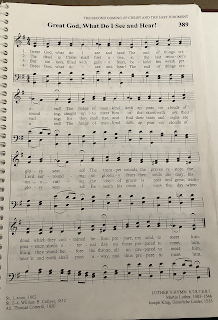My church uses the Trinity Psalter Hymnal. Recently, we sang, Great God, What Do I See and Hear! While singing, I noticed the hymn was credited to Martin Luther (even also alternatively titled, "Luther's Hymn"). What struck me about the hymn was the eschatological language:
Great God, what do I see and hear! The end of things created! The Judge of mankind doth appear on clouds of glory seated! The trumpet sounds; the graves restore the dead which they contained before: prepare, my soul, to meet him.
The dead in Christ shall first arise, at the last trumpet’s sounding, caught up to meet him in the skies, with joy their Lord surrounding; no gloomy fears their souls dismay; his presence sheds eternal day on those prepared to meet him.
But sinners, filled with guilty fears, behold his wrath prevailing; for they shall rise, and find their tears and sighs are unavailing: the day of grace is past and gone; trembling, they stand before the throne, all unprepared to meet him.
Great God, what do I see and hear! The end of things created! The Judge of mankind doth appear on clouds of glory seated! Beneath his cross I view the day when heav’n and earth shall pass away, and thus prepare to meet him.
Certainly as Luther's career progressed, his eschatological expectations did as well. For Luther, the world was on the verge of its end. However, this hymn just didn't sound like Luther to me. I had a brief discussion with a person after the service, and she posited Luther wrote the tune and someone else wrote the words, William B. Collyer. A cursory internet search reveals Collyer was partially the translator and partially the lyricist.
Websites attribute the tune to Luther. While sometimes the words are attributed to Luther, they appear rather to have been partially penned by Lutheran pastor Bartholomäus Ringwaldt (1530-1599) and then later Collyer. This source explains:
"Great God, What Do I See and Hear?"
The history of this hymn is somewhat indefinite, though common consent now attributes to Ringwaldt the stanza beginning with the above line. The imitation of the "Dies Irae" in German which was first in use was printed in Jacob Klug's "Gesangbuch" in 1535. Ringwaldt's hymn of the Last Day, also inspired from the ancient Latin original, appears in his Handbuchlin of 1586, but does not contain this stanza. The first line is, "The awful Day will surely come," (Es ist gewisslich an der Zeit). Nevertheless through the more than two hundred years that the hymn has been translated and re-translated, and gone through inevitable revisions, some vital identity in the spirit and tone of the one seven-line stanza has steadily connected it with Ringwaldt's name. Apparently it is the single survivor of a great lost hymn-edited and altered out of recognition. But its power evidently inspired the added verses, as we have them. Dr. Collyer found it, and, regretting that it was too short to sing in public service, composed stanzas 2d, 3d and 4th. It is likely that Collyer first met with it in Psalms and Hymns for Public and Private Devotion, Sheffield 1802, where it appeared anonymously.
-snip-
Batholomew Ringwaldt, pastor of the Lutheran Church of Longfeld, Prussia, was born in 1531, and died in 1599. His hymns appear in a collection entitled Hymns for the Sundays and Festivals of the Whole Year.
Rev. William Bengo Collyer D.D., was born at Blackheath near London, April 14, 1782, educated at Homerton College and settled over a Congregational Church in Peckham. In 1812 he published a book of hymns, and in 1837 a Service Book to which he contributed eighty-nine hymns. He died Jan. 9, 1854.
THE TUNE.
Probably it was the customary singing of Ringwaldt's hymn (in Germany) to Luther's tune that gave it for some time the designation of "Luther's Hymn," the title by which the music is still known -an air either composed or adapted by Luther, and rendered perhaps unisonously or with extempore chords. It was not until early in the last century that Vincent Novello wrote to it the noble arrangement now in use. It is a strong, even-time harmony with lofty tenor range, and very impressive with full choir and organ or the vocal volume of a congregation. In Cheetham's Psalmody is it written with a trumpet obligato.
Vincent Novello, born in London, Sept. 6, 1781, the intimate friend of Lamb, Shelley, Keats, Hunt and Hazlitt, was a professor of music who attained great eminence as an organist and composer of hymn-tunes and sacred pieces. He was the founder of the publishing house of Novello and Ewer, and father of a famous musical family. Died at Nice, Aug. 9, 1861.Conclusion
A closer look at the Trinity Psalter hymnal demonstrates careful documentation. Stanza one is documented as "anon." (anonymous), though as explained above, Stanza one is probably from Ringwaldt. Stanza 2-4 are rightly attributed to Collyer. "Joseph Klug, Geistliche Lieder," is also referenced. Linking Klug with this German title is a reference to a hymnal of Luther's definitive hymns printed during his lifetime. Here's a 1535 edition. Note the similarities to this Lutheran hymnbook.







No comments:
Post a Comment